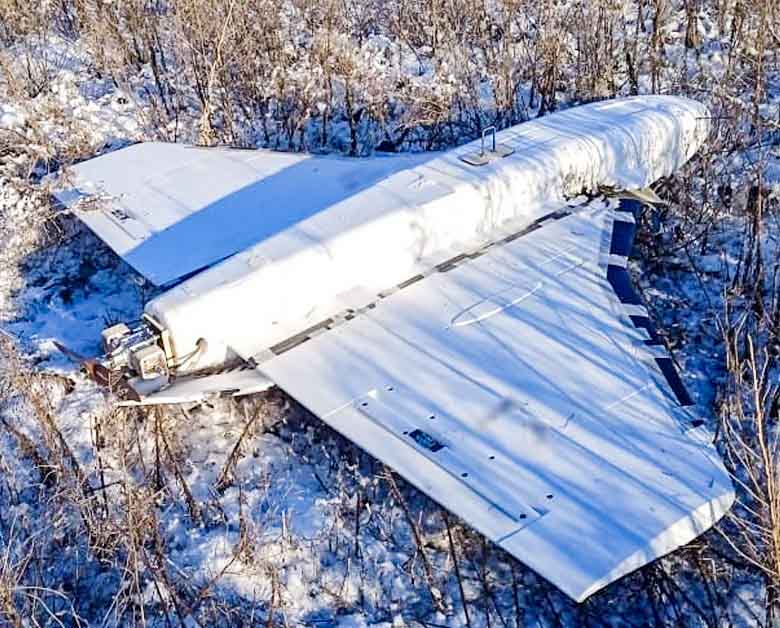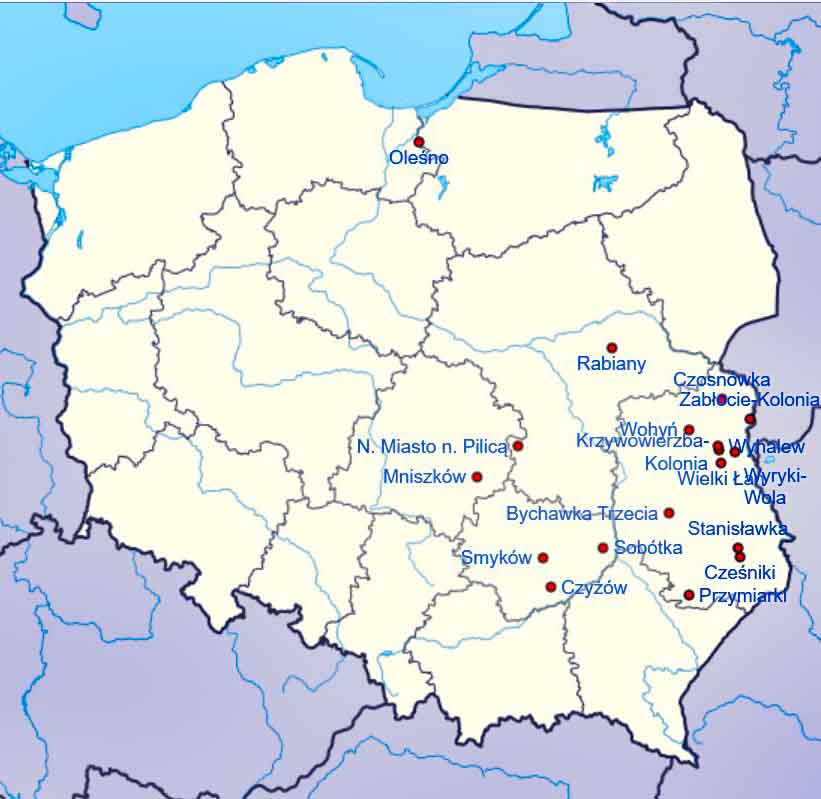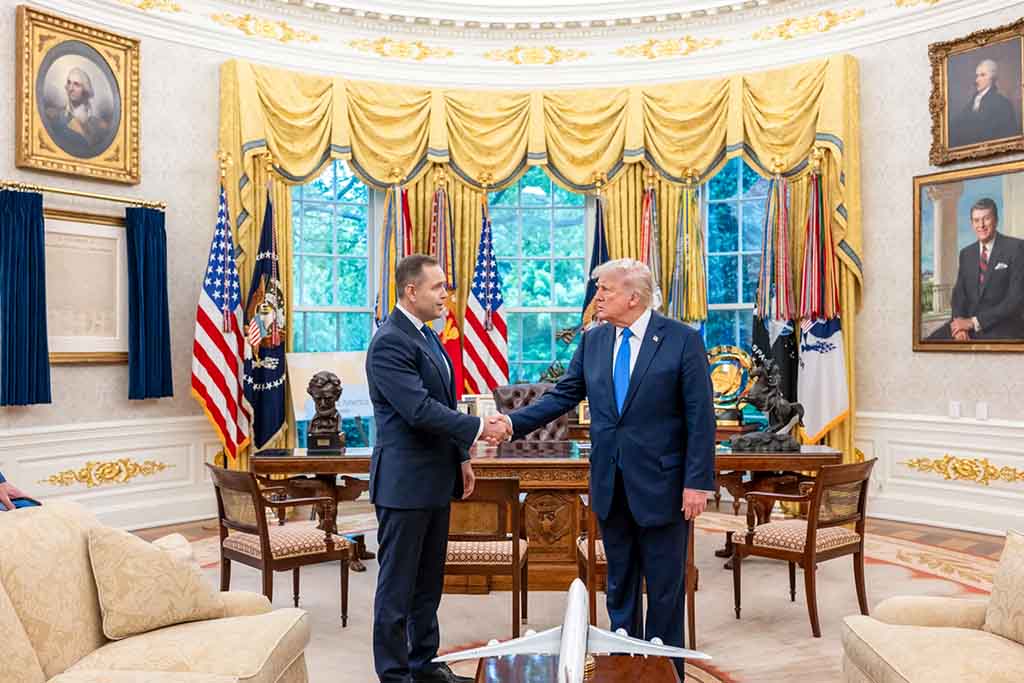On the night of September 9-10, 2025, over twenty enemy drones appeared over Poland's eastern border, violating Polish airspace. According to reports, most of these drones were likely Gerbera-type drones stemming from the Iranian Shahed.

Russian Gerbera drone (Source: Wikipedia)
Photographs and statements from the prosecutor's office indicate that the drones that fell or were shot down in Poland did not carry warheads or reconnaissance equipment. Some of the drones were shot down by the Polish Army with the assistance of NATO allies. This is the first time in modern Polish history that the Air Force – Polish F-16s and Dutch F-35s – have used weaponry in Poland's airspace. During the drone shootdown, a house in the village of Wyryki was damaged, likely by a dud Polish missile fired from an F-16. In the following weeks, debris from drones was found in several voivodeships, most notably in the Lublin province.
The incident itself was relatively small in scale, but its geopolitical significance was enormous. It demonstrated how significantly the nature of modern threats has changed and how easily inexpensive, unmanned systems can penetrate NATO borders. I was in Poland at the time and observed both the media hysteria and the mushrooming conspiracy theories, which were, oddly enough, aligned with the Kremlin's narrative.
Warsaw's Reaction
On September 10, Poland requested NATO to trigger Article 4 of the North Atlantic Treaty (urgent consultations in the event of a perceived threat). Consultations within this framework were held the same day. A day later, President Karol Nawrocki convened the National Security Council, and on September 12, at Poland's request, an emergency meeting of the UN Security Council was held.
Warsaw's long-term response was decisive: Poland will build its own "drone wall" without waiting for Brussels' decisions. The system is to be developed quickly—the first components within a few months, and the full architecture within about two years. This is an expression not only of security concerns but also evidence that countries on the front lines of European security sometimes have to act faster than the rest of the continent.
Poland's decision to bypass the EU's anti-drone wall isn't just pragmatic – it's a devastating indictment of Brussels, demonstrating its inability to keep pace with modern threats.
Were these Russian drones?
Although most political and military commentators point to Russia as the most likely perpetrator of the September incident, publicly available data does not allow for 100% certainty. Analysis of the incident therefore relies on a combination of circumstantial evidence, geopolitical context, and technical evaluation of available information. Hence, a multitude of theories have emerged challenging the Russian origins.
1. Flight trajectories – ambiguous analysis
Western analysts emphasized that the violation of Polish airspace occurred in sections of the border particularly vulnerable to Russian and Belarusian activity. However, no radar data was published that would clearly indicate the drones' flight path from takeoff to the border violation. This lack of such information is typical—both NATO and its member states rarely publish raw military radar data.
As a result, although the probability of Russian or Belarusian origin of the drones is very high, the public does not have hard evidence that could be clearly analyzed.
2. No confirmation of the technical characteristics of the drones
Another concern is that none of the drones that violated airspace were recovered in a condition that allowed identification of the manufacturer, avionics systems, or unique electronic components. In similar cases in the past, the origin of the devices was determined based on:
- serial numbers of components,
- communication protocols,
- firmware used,
- characteristic structural elements.
Here, however, such data was not disclosed – which may mean that they were either not found, are covered by operational secrecy, or did not produce clear results.
3. No SIGINT evidence publicly available
SIGINT (Signals Intelligence), or the interception of radio signals and telemetry, plays a key role in drone incidents. This allows for the identification of control protocols, modulation methods used, frequencies characteristic of Russian systems, and transmission direction.
In the case of the September incident, no NATO country or Poland itself disclosed the intercepted SIGINT data, although it is usually one of the most important lines of evidence.
Reuters noted that in the initial phase of the incident, "Polish authorities are investigating the origin of the drones," but no hard results of the investigation were indicated.
4. Pointing to Russia - Logical, but still indirect
Much points to Russia as the perpetrator. First, the timing and location of the incident correlated with Russia's intense drone activity in the region. Second, Russia has a strategic interest in testing NATO defenses and is undoubtedly continuing similar activities in the Baltic states, including Denmark and near the Reedo NATO base in Estonia (October 18).
However, as OSW expert Andrzej Wilk emphasizes:
Russian origin is most likely, but not confirmed by publicly presented evidence.” (OSW Analysis — Drone Incidents on the Eastern Flank, 2025)
This means that public opinion is now based primarily on context analysis rather than on released technical data.
5. Belarus as an alternative hypothesis
Some analysts suggest the incident may have been carried out from Belarusian territory—either independently or on Moscow's orders. Belarus possesses both drone capabilities and the logistical resources to operate below the threshold of war. Previous episodes of border provocations are also known. However, here too, there is no public evidence, only strategic analyses.
6. If they are Russian, they arrived by accident
NATO Secretary General Mark Rutte said on Fox News in October that the violation of Polish airspace by – according to him, nevertheless – Russian drones in September was not a deliberate act but, as far as they can determine, it was not intentional, and at most reckless.
Probably as accidental as the violations of the airspace of other NATO countries that occur every so often.
Or maybe Russian after all...
Paradoxically, the Russian origin of the drones over Poland may be evidenced by the activity of... Russian intelligence services. The incident itself became the catalyst for a widespread propaganda operation conducted by pro-Russian influence agents whose goal was to obscure the situation and create information chaos.
The Google Threat Intelligence Group (GTIG) analyzed the disinformation campaign that emerged almost immediately after the violation of Polish airspace. The report clearly indicates that Russia, using a network of affiliated portals and false identities—such as Portal Kombat, Doppelganger, and Niezalezny Dziennik Polityczny (NDP, Independent Political Daily)—has launched a campaign aimed at deflecting responsibility, targeting the Polish government, and undermining trust in NATO and its Western allies.

Map of drone crash sites in Poland, September 2025 (Source: Wikipedia)
According to Google's analysis, the narratives circulated after the incident bore all the hallmarks of classic Kremlin influence operations. One plot attempted to whitewash Moscow's actions by suggesting that the drones "by definition" could not have originated in Russia. Another accused NATO and Poland of an alleged provocation aimed at strategic talks with the US. At the same time, the legitimacy of the Polish government was questioned, portraying it as responsible for the escalation and alleged internal instability.
A fourth strand was added: the narrative that Ukraine may have deliberately orchestrated the incident to "drag Poland into the war." This was an attempt to drive a wedge between Warsaw and Kyiv, weaken Polish-Ukrainian solidarity, and raise suspicions about the partner fighting Russian aggression. This is a technique well-known from previous influence operations—when the Kremlin is unable to credibly deny its actions, it at least tries to distract attention by creating numerous alternative, emotionally appealing versions of events.
In total, a mosaic of manipulated narratives emerged with one goal: to weaken Poland's response, undermine Western unity, and divert attention from the obvious fact that the drone incident—regardless of its technical details—was a test of the NATO state's resilience and would not have happened at all if not for Russia's earlier aggression.
It's important to remember that much of the information released by Russian media or government officials is propaganda. Such reports are part of the information war waged by the Russian Federation.
In any case, although no clear, tangible evidence has been publicly presented to date confirming that the drones that violated Polish airspace in September were directly of Russian origin, the incident itself proved to be a sufficient impulse for decisive mobilization on the Polish side.
The uncertainty surrounding the attack's source did not diminish its operational significance—on the contrary, it made the authorities in Warsaw aware that even actions with unclear origins can truly test a country's resilience and response mechanisms. It was this ambiguity, coupled with the risk of further violations, that prompted Poland to immediately accelerate the construction of its own "drone wall" and strengthen its air defense systems, viewing the incident as a warning that should not be ignored.
A New Era of Threats
The war in Ukraine has fundamentally changed our understanding of the modern battlefield. Drones have become one of its most important elements:
- they conduct reconnaissance
- they direct artillery fire
- they attack vehicles, fortifications and infrastructure facilities
- they operate in swarms
- they cost a fraction of the price of traditional weapons systems
- it is not profitable to fight them with traditional methods (e.g. expensive surface-to-air missiles)
At the same time, they are difficult to detect and neutralize. The ability to counter these threats has become one of the most important defense challenges for NATO countries, especially those—like Poland—located on the eastern flank.
The September 2025 incident revealed three facts:
- The Polish border requires immediate reinforcement at the anti-drone level.
- Drones are not subject to classic rules of escalation—it is difficult to respond to them symmetrically.
- European response mechanisms are too slow to respond to dynamic threats.
In this context, Poland's decision to build its own "drone wall" appears pragmatic and necessary.
Poland is moving faster than the European Union
Poland has announced the construction of the system in two stages:
- Rapidly deploy drone detection and jamming capabilities—in months.
- Build a multi-layered, comprehensive “drone wall”—in two years.
Cezary Tomczyk, Secretary of State of the Ministry of National Defence, stressed that Poland does not intend to wait for the EU concept of a common anti-drone shield to be developed.
The EU's plan, while ambitious, involves complex multilateral financing, unified procedures, industrial division of labor among member states, and the implementation of a unified command and control architecture. This is a process that will take years.
Meanwhile, Poland needs protection immediately — not only for its own borders, but also for NATO troops stationed on its territory.
What is a "wall of drones"?
Contrary to popular belief, it is not about a single installation line, but about an integrated multi-layer system based on four pillars:
1. Early detection and sensor fusion
The first layer of the system is early detection and sensor fusion, encompassing the cooperation of active and passive radars, radio signal detectors, electro-optical and infrared (EO/IR) cameras, and acoustic systems, whose data is then integrated and analyzed by artificial intelligence algorithms for precise threat classification.
2. Electronic Warfare
The second layer is electronic warfare – jamming the control signal and jamming GPS/GNSS navigation systems, attempting to take control of enemy platforms and using mobile jamming platforms, all in order to weaken the enemy’s coordination and navigation capabilities and effectively counter drone swarms.
3. Hard-kill layer
The third layer is the "hard-kill" element — the physical neutralization of threats using anti-drone missiles and programmable munitions, very short-range systems (e.g. PILICA+) and, in subsequent stages of development, technologies such as lasers or microwave weapons.
4. Command and Control Integration
Poland already possesses some of the best C4ISR (Command, Control, Communications, Computers, Intelligence, Surveillance, Reconnaissance) systems in Europe—including those from WB Group—that integrate artillery, reconnaissance, and air defense. The "Drone Wall" will be integrated with these systems, along with Patriots, NAREW, F-35s, and NATO structures.
Industrial dimension - Poland focuses on its own companies
Warsaw makes no secret of the fact that the project also has strategic and economic dimensions. Secretary Tomczyk clearly declared:
At least half of the orders must go to Polish companies.
This requirement ensures:
- operational independence - no one can "switch off" this system or prohibit its use,
- modernization independence,
- possibility of immediate corrections and modifications,
- development of Polish technologies,
- increase in the export potential of the arms industry.
The main beneficiaries will include:
- PIT-RADWAR – radars and command systems,
- PGZ – integration elements and air defense systems,
- WB Group – communication and integration at the battlefield level,
- Advanced Protection Systems – anti-drone systems,
- Griffin Group – mobile jamming solutions.
Poland already exports anti-drone systems to many NATO countries – building a “drone wall” will only accelerate this trend.
Why is the Eastern Flank Crucial?
Poland borders the heavily militarized Kaliningrad Oblast, Belarus, which serves as Russia's operational military base, and Ukraine, a country engulfed in a full-scale war and constantly subjected to massive drone and long-range missile attacks. As a result, this is NATO's most sensitive area, where the interests of three distinct security zones converge: Russian, Belarusian, and Euro-Atlantic. Each of these zones utilizes increasingly advanced unmanned technologies, and national borders are no longer a real barrier to cheap and mobile reconnaissance systems.
In this realm, a potential adversary has the ability to operate below the threshold of war, possessing the ability to use drones almost hand-launched—from civilian cars, small off-road vehicles, improvised platforms, or portable launchers hidden in forested, hard-to-reach areas. Such assets can be launched at any time, and their detection and neutralization often require reactions measured in seconds or minutes, precluding reliance solely on multilateral, time-consuming NATO or European Union procedures.
This is why the border states – Poland, Lithuania, Latvia and Estonia – must have the ability to act immediately, while integrated counter-drone systems are becoming one of the foundations of the security of the entire Alliance.
Cost and scale of the system
The estimated cost of the project is $2.5–5 billion. Considering the Polish defense budget, which is over 5% of GDP (Poland's GDP is estimated at $850–900 billion, 5% is approximately $45 billion), this is a perfectly rational investment.
For comparison:
- the purchase of a F-35 costs over USD 6 billion,
- the Patriot program over USD 10 billion,
- the Krab, Abrams, HIMARS programs — billions more.
Meanwhile, the "drone wall" fills the most important gap in modern air defense – as the war in Ukraine demonstrated – protection against cheap, massive and difficult-to-detect threats.
European Dimension - Poland as NATO Leader
In mid-October, the NATO Secretary General announced that the Alliance was working closely with the European Union to create a so-called drone wall — an integrated anti-drone defense system for member states.
The European Union is working on its own concept of an "anti-drone shield," but the project is politically complex, logistically difficult, slow to make decisions, dependent on the consent of many states, and lacks the sense of urgency that characterizes Poland and the Baltic states.
By building its own system faster, Poland is showing the direction Europe should be heading. This is an example of practical leadership.
NATO regards the Polish project positively, viewing it as a significant strengthening of the Alliance's eastern flank, providing better protection for Allied forces stationed in Poland and the region, and creating an additional layer of reconnaissance that complements existing surveillance and early warning systems. At the same time, this initiative enhances deterrence capabilities by demonstrating to potential adversaries that attempts to test NATO's boundaries with low-cost, unmanned systems will be met with an immediate and multi-layered response, thus raising the cost of conducting hybrid operations against Alliance member states.
All that remains is to ensure full interoperability of the system with the NATO IAMD architecture – and this is a technical, not political, issue.
Conclusion
The "Drone Wall" is not only a technical project but also a symbolic one. It demonstrates that Poland takes responsibility for its own security while simultaneously strengthening the security of all of Europe. In a world where cheap drones can destabilize states and provoke escalation, countries on the flanks of the Western civilization must act quickly and decisively.
Poland's decision isn't an act of defiance against the European Union—it's a call for Europe to wake up and take action. In history, it's not enough to observe—one has to participate. Poland is doing just that.










